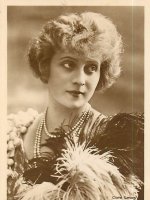Fred LeRoy Granville is a Director British born on 1 january 1896 at Warrnambool (Australie)

Fred LeRoy Granville was born in Warrnambool, Victoria, Australia, in 1896, and educated in New Zealand. The 1 February 1922, issue of American Cinematographer stated that he was "a bloody Britisher by birth" and "first saw the light at Worton Hall, Isleworth, Middlesex, England." Granville became interested in photography as a boy. His first experience with cinematography came in 1913 under the guidance of James Crosby at the Selig Polyscope studio in Edendale, near downtown Los Angeles. Granville photographed the documentary Rescue of the Stefansson Expedition (1914) and a number of features and serials for Universal, including Liberty — A Daughter of the U.S.A. (1916) and The Heart of Humanity (1918). He also shot several of cowboy actor Tom Mix's early Fox features.
While married to Mary J., he had two sons, George E., born about 1908 and Roy F., born about 1911.
In 1920, Granville went to England, where he worked as a cinematographer and director into the mid-1920s. He died in London on 14 November 1932, from complications related to Bright's disease.
Après avoir dirigé les prises de vues d'un documentaire de 1914, ses trois premiers films comme chef opérateur sortent en 1916, dont le serial Liberty de Jacques Jaccard et Henry MacRae (avec Jack Holt et Eddie Polo).
Suivent à ce poste treize autres films muets américains, dont Calvaire d'amour (avec Mae Murray et Lew Cody) et Fleur des ruelles (avec Mae Murray et Kenneth Harlan), tous deux réalisés par Robert Z. Leonard et sortis en 1918, le western The Coming of the Law d'Arthur Rosson (1919, avec Tom Mix et Agnes Vernon), ou encore L'oiseau s'envole d'Allen Holubar (son dernier film comme directeur de la photographie, 1920, avec Dorothy Phillips et Rudolph Valentino).
En 1920, il s'installe en Angleterre où il devient réalisateur, avec deux premiers films sortis cette même année, At the Mercy of Tiberius et The Honeypot, ayant pour vedette Peggy Hyland (qu'il épouse en 1921 mais dont il divorcera rapidement).
Il réalise cinq autres films muets britanniques sortis entre 1921 et 1925, dont The Beloved Vagabond (1923, avec Carlyle Blackwell).
En outre, il est le réalisateur de quatre films muets américains sortis en 1921 et 1922, dont The Shark Master (1921, avec Frank Mayo) et La Tempête dans le désert (1922, avec Peggy Hyland).
Sa carrière de réalisateur s'achève sur trois films français — il y est crédité Fred Leroy-Granville —, Le Berceau de Dieu (1926, avec Léon Mathot et Musidora), Lady Harrington (1926, avec Claude France et Maurice de Féraudy) et enfin Sous le ciel d'Orient (1927, coréalisé par Hewitt C. Grantham-Hayes, avec Gaston Modot et Joë Hamman).
Signalons encore deux films comme producteur sortis en 1925, Forbidden Cargoes (film britannique qu'il réalise, avec Peggy Hyland) et Le Puits de Jacob (film français d'Edward José, avec Betty Blythe et Léon Mathot).
Au nombre des quinze membres fondateurs en 1919 de l'American Society of Cinematographers (ASC), Fred LeRoy Granville meurt prématurément en 1932 (à 36 ans), des suites d'un dysfonctionnement des reins.
Source : Wikidata
Fred LeRoy Granville

Nationality United-kingdom
Birth 1 january 1896 at Warrnambool (Australie)
Death 14 november 1932 (at 36 years)
Birth 1 january 1896 at Warrnambool (Australie)
Death 14 november 1932 (at 36 years)
While married to Mary J., he had two sons, George E., born about 1908 and Roy F., born about 1911.
In 1920, Granville went to England, where he worked as a cinematographer and director into the mid-1920s. He died in London on 14 November 1932, from complications related to Bright's disease.
Biography
Fred LeRoy Granville débute en 1913 à la Selig Polyscope Company, aux États-Unis, pays où il travaille ensuite au sein d'Universal et de la Fox, jusqu'en 1920.Après avoir dirigé les prises de vues d'un documentaire de 1914, ses trois premiers films comme chef opérateur sortent en 1916, dont le serial Liberty de Jacques Jaccard et Henry MacRae (avec Jack Holt et Eddie Polo).
Suivent à ce poste treize autres films muets américains, dont Calvaire d'amour (avec Mae Murray et Lew Cody) et Fleur des ruelles (avec Mae Murray et Kenneth Harlan), tous deux réalisés par Robert Z. Leonard et sortis en 1918, le western The Coming of the Law d'Arthur Rosson (1919, avec Tom Mix et Agnes Vernon), ou encore L'oiseau s'envole d'Allen Holubar (son dernier film comme directeur de la photographie, 1920, avec Dorothy Phillips et Rudolph Valentino).
En 1920, il s'installe en Angleterre où il devient réalisateur, avec deux premiers films sortis cette même année, At the Mercy of Tiberius et The Honeypot, ayant pour vedette Peggy Hyland (qu'il épouse en 1921 mais dont il divorcera rapidement).
Il réalise cinq autres films muets britanniques sortis entre 1921 et 1925, dont The Beloved Vagabond (1923, avec Carlyle Blackwell).
En outre, il est le réalisateur de quatre films muets américains sortis en 1921 et 1922, dont The Shark Master (1921, avec Frank Mayo) et La Tempête dans le désert (1922, avec Peggy Hyland).
Sa carrière de réalisateur s'achève sur trois films français — il y est crédité Fred Leroy-Granville —, Le Berceau de Dieu (1926, avec Léon Mathot et Musidora), Lady Harrington (1926, avec Claude France et Maurice de Féraudy) et enfin Sous le ciel d'Orient (1927, coréalisé par Hewitt C. Grantham-Hayes, avec Gaston Modot et Joë Hamman).
Signalons encore deux films comme producteur sortis en 1925, Forbidden Cargoes (film britannique qu'il réalise, avec Peggy Hyland) et Le Puits de Jacob (film français d'Edward José, avec Betty Blythe et Léon Mathot).
Au nombre des quinze membres fondateurs en 1919 de l'American Society of Cinematographers (ASC), Fred LeRoy Granville meurt prématurément en 1932 (à 36 ans), des suites d'un dysfonctionnement des reins.
Usually with
Filmography of Fred LeRoy Granville (3 films)
Director

The Cradle of God (1926)
Directed by Fred LeRoy Granville
Origin France
Genres Drama
Actors Léon Mathot, Joë Hamman, Gabriel Signoret, Stacia Napierkowska, Musidora, Rachel Devirys
L'écrivain John Powers, ayant perdu la foi à la mort de sa fiancée, se lance dans l'écriture d'un pamphlet discréditant toute religion et se rend à Jérusalem. Puis, errant en Palestine, il rencontre dans un village la jeune Ruth qui tente de lui faire retrouver la foi. S'endormant, il rêve qu'il rencontre des protagonistes de l'Ancien Testament...

Lady Harrington (1926)
Directed by Fred LeRoy Granville
Origin France
Actors Claude France, Maurice de Féraudy, Warwick Ward, Joë Hamman, André Dubosc

The Beloved Vagabond (1923)
Directed by Fred LeRoy Granville
Origin United-kingdom
Actors Carlyle Blackwell, Cameron Carr, Ernest Hilliard, Jessie Matthews
The wealthy Gaston de Nerac (Blackwell) decides to live as a tramp until he falls in love.
 Connection
Connection



